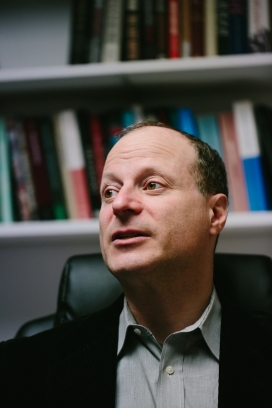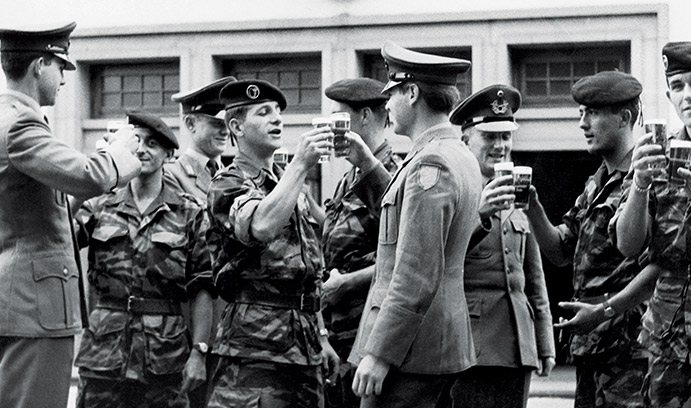A Prescription for Peace

Successful peacemaking between longstanding adversaries, argues Norrin Ripsman, is almost always imposed by states from the top down and then sustained by societies. (Illustrations by Emmanuel Polanco)
Promoting Peace
Those who doubt that peace can ever be achieved between deadlocked adversaries such as Israel and the Palestinians, says Norrin Ripsman, might find hope in the example set by France and Germany.
Between 1870 and 1945, says Ripsman, the Monroe J. Rathbone Professor in the department of international relations, the two European neighbors fought three bitter wars—the Franco-Prussian War of 1870-71, World War I (1914-18) and World War II (1939-45).
“The death and destruction caused by the wars involving Israel in the Middle East,” says Ripsman, “pale in comparison to the death and destruction caused by the three Franco-German wars. And the hatred that the French once held toward the Germans is almost impossible for us to imagine today.”
In annual surveys conducted by the French Institute of Public Opinion, says Ripsman, the French until the early 1960s ranked Germany near the bottom when asked to list their country’s friends among the other nations of Europe. By the early 1970s, the surveys found, West Germany had become France’s best friend in Europe; by 1980, it was France’s best friend in the world.

In 1989, when East and West Germany were reunified, 80 percent of Frenchmen said they would not fear German rearmament if it were done in the context of European institutions and democracy.
Ripsman explores the causes of this turnaround in a chapter in his latest book, Peacemaking from Above, Peace from Below: Ending Conflict Between Regional Rivals, which was published last year by Cornell University Press. The book also devotes separate chapters to the Egyptian-Israeli peace treaties of 1978-79 and the Israeli-Jordanian Treaty of 1994. A fourth chapter examines other examples of peacemaking efforts. Each study involves a neighboring pair of nations of comparable power.
In writing Peacemaking from Above, Ripsman conducted personal interviews, did archival research and consulted secondary sources of peace treaties. He concludes that successful peacemaking is almost always imposed by governments and stabilized by societies. Governments, he says, often disregard societal objections. Their motivations include concerns over a third state that poses a greater threat to security than the adversary, pressure from a powerful outside actor, and economic troubles that threaten their hold on power.
In contrast, peace is sustained by societal groups through cultural and economic exchanges, trade, and mutual cooperation in international institutions. The prospects for long-lasting peace, Ripsman says, improve if adversary states begin to democratize, if dispersed ethnic groups are reunited, and if stateless minorities gain self-determination.
His findings, says Ripsman, have practical as well as theoretical significance. Western nations and international organizations, he believes, squander money, time and energy by investing in bottom-up peacemaking efforts between adversaries before their governments have agreed to make peace. For example, the U.S., the European Union (EU) and Japan all support exchange programs involving Israeli and Palestinian children, and Pakistani and Indian children, although their nations’ governments have not yet agreed to make peace.
“We waste a lot of resources putting the cart before the horse by spending on bottom-up strategies,” Ripsman says. “We need to promote peace properly and stabilize it properly. “We need to achieve agreement by giving incentives to rival states or by putting pressure on these states and using a carrot and stick when appropriate.”
Ripsman, who joined Lehigh’s faculty in 2016, spent more than a decade working on Peacemaking from Above. During this time, he coauthored three other books, coedited four and served on the faculty of Concordia University in Montreal. His first book, Peacemaking by Democracies: The Effect of State Autonomy on the Post–World War Settlements, was published in 2002.
Peacemaking from Above grew out of an article Ripsman wrote on Franco-German peacemaking after World War II, which was published in 2005 by the International Studies Quarterly.
“I began to wonder if the lessons from France and Germany could be generalized beyond Western Europe, which is a large and homogeneous region from the standpoints of culture, institutions and religion. Could these lessons be portable to the Middle East or South Asia, which are tremendously different? Or did the Franco-German example explain just one case?”
A second motivation for writing Peacemaking from Above was Ripsman’s conviction that the prevailing theories of peacemaking—liberal, realist and constructivist—did not fully explain it.
“One reason I decided to write my second book was that I was not satisfied with existing theoretical tools. Realists believe states make peace over the objection of their societies. Constructivists say peace occurs because societal attitudes change and compel leaders to change. They believe international institutions play a role.
“Liberals say peace occurs because of societal factors. They believe societies are more rational, and that if you change incentives, people will change their behavior. If people see they can gain economically by achieving peace, or that they stand to lose otherwise, they will calculate the costs of continuing a conflict and opt for peace.”
Each of these theories explains part of the success of Franco-German peacemaking, Ripsman says. After World War II, French leaders faced an unchanging reality: the victorious, expansionist Soviet Union posed a greater threat to French security than did devastated and defeated Germany. Also, the United States was pressuring France to make peace, and France’s leaders realized the need to stabilize the fragile French Fourth Republic. These factors helped motivate French leaders in 1954 to sign a peace treaty with West Germany and agree to its rearmament under NATO supervision.
“Statist factors, including a common Soviet threat, U.S. economic and military incentives, and regime-survival and state-building motives, brought about Franco-German cooperation and peace,” Ripsman writes in Peacemaking from Above. “There is no evidence [that] public pressures, significant pressure from business interests, or a common identity created by participation in powerful regional institutions compelled peacemaking.”
But if peace was imposed from the top, Ripsman writes, it was stabilized and socialized “with liberal and constructivist mechanisms. In particular, the entrenchment of German democracy within a network of economic interdependence…helped abate societal antagonism and build a foundation for a stable peace.”
“Since the signing of the treaty,” says Ripsman, “relations between France and Germany have been characterized by a high degree of interdependence, trade and cultural exchanges. The two nations belong to a variety of institutions, which are well-established, such as the European Economic Community—now the EU, and the Council of Europe, not to mention NATO. Both states are now democracies and the region they occupy is a zone of democratic peace.”
In sharp contrast to France and Germany, says Ripsman, Egypt and Israel have failed to build a stable peace since signing the Camp David Accords (1978) and the Egypt-Israel Peace Treaty (1979), which were facilitated by the U.S.

The two nations had geopolitical reasons for initiating a rapprochement—Egypt desired the return of the Sinai Peninsula that Israel had conquered and occupied since the Six-Day War of 1967, while Israel hoped to pacify the most powerful of the Arab states with which it had fought several wars since achieving its independence in 1948. And U.S. President Jimmy Carter had coaxed the two former adversaries to make peace with offers of military and economic assistance.
But, says Ripsman, while Egyptian President Anwar Sadat and Israeli Prime Minister Menachem Begin made peace over the objections (especially in the case of Egypt) of their respective populations, their nations failed to stabilize the peace with liberal and constructivist approaches.
“Israel and Egypt have achieved an enduring settlement,” says Ripsman, “but you cannot call this a stable settlement. There has been no war or repudiation of the treaty since Camp David in 1978. But there have been frequent crises and attempts to revise the treaty, and there has been no societal buy-in, no significant effort to bring society on board through democratization or economic exchanges.”
When Egypt and Israel signed the Camp David Accords, says Ripsman, they also ratified 65 economic, social and cultural protocols. None of these has been implemented, however, since the assassination of Sadat in October 1981. Nor do the two nations cooperate in any significant international institutions. And although Israel returned the Sinai Peninsula to Egypt, it has failed to resolve the state-to-nation issue with the Palestinians.
As a result, Ripsman writes in Peacemaking from Above, the peace agreement between Israel and Egypt remains precarious, dependent on the whims of the nations’ governments, especially Egypt’s.
“If the Egyptian military were to relinquish power, to the extent that Egypt undergoes a democratization process, the possibility exists that a government hostile to the treaty could rise to power and no longer view peace as consistent with Egypt’s state interests.”
“Had serious attempts been made by outside actors such as the U.S. and by the Egyptian and Israeli governments to bring the rival societies on board after the peace treaties were signed,” he says, “we would see a greater chance for an enduring treaty.”
In his next book, Ripsman plans to explore the role of religion in national security and international peacemaking efforts.
“Religion does complicate peacemaking in some regions,” he says. “But in writing my latest book, I found that when peace occurs despite religious differences, it occurs because of the same top-down mechanisms. Religion does not change the nature of how peace must occur.”
This story appears as "Promoting Peace" in the 2017 Lehigh Research Review.
Posted on:







